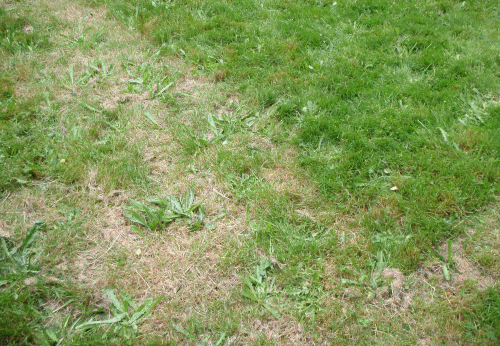








Gerry Miller
Organic Consultant
















Gerry Miller
Organic Consultant




Gerry Miller wrote:
You have what is typical housing development soil, that as you say, the good stuff was scrapped off and then they built your home and put down some mostly clay filler junk.
Your plan to put down better soil can be a good one, but much depends on where you are going to purchase that soil from? Hopefully not the same type of developer that uses that crappy clay material. The only way you'll know for sure is to check out the operation where you are going to buy the soil.
Many topsoil dealers screen their topsoil to remove all the stones, sticks, and other junk that shows up in urban soils. Screening is fine, it makes for some good topsoil.
But some dealers have topsoil that has a heavy clay base and they end up shredding the soil to make it loose and look good for the buyer. You don't want to buy that stuff as it will turn to mud when it gets wet and then will dry hard as a rock. It's lacking organic matter!
So when you inspect where they process the topsoil, check it out and see if it is, in fact, tiny little balls. If it is, it's the result of shredding. You won't see that if it's good loam soil rich with organic matter.
If possible, look for piles of raw topsoil and inspect them. Ignore the weeds as good topsoil should be covered with weeds unless it's turned frequently. If you can see the teeth of a backhoe in the soil, you know it's made up of mostly clay.
But you have another option. Instead of purchasing topsoil, improve the soil you have already. It will take a bit longer to get your soil in balance, but you'll know for sure what's in your soil.
You just need a couple of things to get started. First, you need to have your lawn core aerated. Remember we are trying to get your soil in balance, so the next step after core aeration is to apply some Mycorrhizal Fungi with a hose end sprayer, mix the fungi and apply to your soil, particular the to the new holes. Here is the link where you can purchase these critters:
http://www.fungi.com/mycogrow/index.html
After the core aeration and apply the fungi, then you want to topdress your lawn with compost (chances are you don't have compost or at least not enough for your lawn) or other organic material, like dehydrated cow manure. You want to apply between 1/4 to 1/3 of an inch to your soil. The use of a compost spreader is highly recommended. I'm not sure if you can rent them, but for $100 investment for something you'll use again in the future, it's worth it.
Then when you are finish with the, you'll want to apply 20 lbs per 1000 sq ft alfalfa meal. This can be purchased cheaply from your local feed store. Alfalfa Meal (3-1-2) is very high in Vitamin A, Thiamin, Riboflavin, Pantothenic Acid, Niacin, Pyridoxine, Choline, Proline, Bentaine, Folic Acid, plus N-P-K, and trace elements. It also contains sugars, starches, proteins, coenzymes, and amino acids. All this to feed the soil biology in your soil. It alfalfa meal is not available, soybean meal is good as well. In fact, during the course of the year, you want to use different protein meals to feed the soil foodweb. When you use these protein meals, you are adding organic matter to your soil at the same time feeding the soil biology.
The next step is to learn to make your own Aerated Compost Tea. This is a way to supercharge your soil with the soil organisms you need for your soil to be healthy. It's easy to make and to apply. Check out Soil foodweb for all the information you'll ever need about compost tea:
http://www.soilfoodweb.com/03_about_us/approach.html
You may want to search the web for different compost tea brewers that are available. I highly recommend the KIS brewers. I use the 5 gallon system. Here is their link:http://www.simplici-tea.com/
I know this is a lot of information to throw at you at one time. But this will put you on the right track to improve your soil so you can have a healthy lawn. Can't have a healthy lawn without healthy soil.
I hope this was helpful and didn't scare you off with the the info. Just take it slow and do some reading.
Gerry Miller actually , I like your methods better. I think I can have more control over what I turn my lawn into. thanks for the info.




thanks for your input I think I'll try both methods since I have sizeable back and front lawns. i'm not particularly lazy but I am definitely cheap.paul wheaton wrote:
A slower road to improving your soil is to fertilize and mow. Your crappy subsoil can be converted to something useful. Gerry has described some great stuff - but that might be a bit more than a cheap and lazy person would be willing to do.
If you just follow the steps in the page, the soil will slowly evolve.
But ... if you are not so patient and have the cash - Gerry's stuff will work too!




Gerry Miller
Organic Consultant








Gerry Miller
Organic Consultant








Gerry Miller
Organic Consultant








Gerry Miller
Organic Consultant

|
This is my favorite show. And this is my favorite tiny ad:
Freaky Cheap Heat - 2 hour movie - HD streaming
https://permies.com/wiki/238453/Freaky-Cheap-Heat-hour-movie
|


